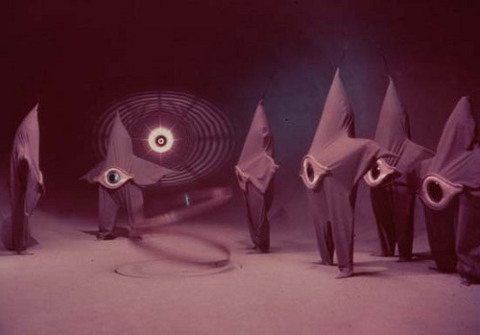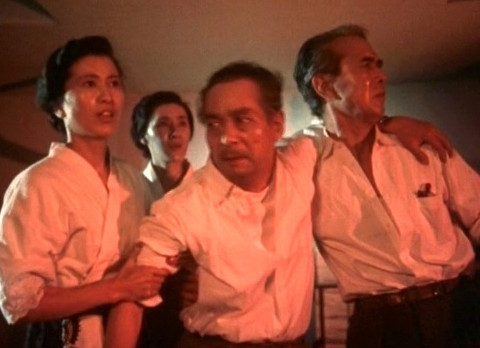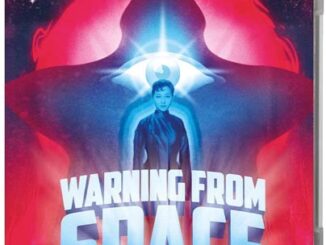Warning From Space (1956)
Directed by: Kôji Shima
Written by: Gentaro Nakajima, Hideo Oguni
Starring: Bontarô Miake, Keizô Kawasaki, Kiyoko Hirai, Toyomi Karita
AKA UCHUJIN TOKYO NI ARAWARU, SPACEMEN APPEAR OVER TOKYO, THE MYSTERIOUS SATELLITE
JAPAN
AVAILABLE ON BLU-RAY: NOW, from ARROW VIDEO
RUNNING TIME: 86 mins
REVIEWED BY: Dr Lenera
Doctors Kamura, Matsuda and Itsobe are investigating sightings of flying saucers over Tokyo; when Matsuda sees what looks like small spacecraft emitting from a larger one and coming to earth through the telescope in his observatory, it’s clear that something strange is going on. Then people start seeing peculiar creatures who seem to have one huge glowing eye. It turns out that they are beings from the planet Paira, and, seeing the reaction by Earth folk to their original form, choose one of their race to take the form of Hikari Aozora, a popular singer. Hopefully then she’ll be able to warn Earth of not just the danger of nuclear weapons but of an even deadlier catastrophe threatening the planet….
If you’ve been reading this website for long enough, you’ll remember my go-through a few years ago of not just all the Godzilla films but all the monster movies made by Toho and many of their science fiction excursions too. Therefore I was understandably excited when, following on from their terrific boxset of all of all the films from Daiei [reviewed in two parts here and here] which featured the giant flying turtle Gamera, the news broke that Arrow were going to released Daiei’s Warning From Space, which proceeded the Toho non-kaiju sci-fi efforts and was the first Japanese film to feature aliens. Not knowing so much about these non-Tohos and there being less information about them, I won’t be able to bombard you with background information, but will certainly have plenty to say about this film, which is undeniably flawed but which should be of great interest to sci-fi fans, especially those with a predilection for the ’50s where it seems like, inspired by a UFO craze, you could barely move at times for all the creatures from outer space that visited Earth in movies. Most of them were malevolent, but occasionally we were lucky enough to receive some friendly extra-terrestrials, as in The Day The Earth Stood Still. Warning From Space, and no doubt the novel of the same title by Gentaro Nakajimais which it was adapted from, was quite obviously inspired greatly by that classic, as well as When Worlds Collide; elsewhere it seems to quite consciously borrow themes and situations from various other sci-fi efforts. What makes it so interesting is that it puts a very Japanese slant on them, far more so than the likes of Toho’s Battle In Outer Space which, following on from the international success of Godzilla, were clearly made with one eye on the western market. This might explain why its theatrical distribution was either held up or fairly limited outside of Japan.
The approach is sober, even intelligent. There are a fairly large set of characters, while there are far more vignettes featuring folk we never hear from again than you’d normally expect, the emphasis being on the group rather than the individual; even a potential romantic subplot is raised and then ignored for the rest of the film. All this not only keeps the pace of what is quite a talky production moving forward, but also gives the proceedings a sense of scale which otherwise they may not have for two reasons; the majority of the main action taking place in an observatory and a school right next door to it, and there clearly not being much money for big special effects scenes, though there are a few shots that are pretty impressive for the time. It’s mostly rather calm and considered even if we’re still always aware that the End of the World could be nigh, though this might seem like a silly thing to say in a film that also features star-fish aliens with huge eyes on their stomachs that never look anything other than humans trapped in huge pillowcases, and which seem expressly designed to end up in kid’s bedrooms. But then Japanese filmmakers were never overly concerned with realism anyway when visualising the fantastique, and at least here they tried to something different to the usual humanoids; in fact the Gamera films also sometimes showed that Daiei could be a bit more ambitious than Toho is realising beings from another planet, even if they tended not to have enough money to do the job as well as it could have been done.
So we’re first introduced to Dr. Kamura, a leading astronomer meeting his newspaperman pal Hoshino for dinner, and you’ve got to chuckle at the way the astronomers in this movie all wear lab coats when they’re in the observatory. Hoshino shows the Doctor an article he’s written about the flying saucers seen over the city recently; he then tries to pump him for more information but Kamura tells him nothing. Meanwhile Kamura’s daughter Taeko is eating round the house of Kamura’s cousin Dr. Matsuda, and has just turned down a proposal from Dr. Toru Isobe [yes, three main scientist characters in this one, and that’s not including Toru’s father]. All this it got out of the way very quickly as more flying saucers are seen, radio interference takes place and fish seem to have disappeared from Tokyo Bay. Then the Pairans themselves start appearing to folk, and these moments, where we only see brief or far-off glimpses, are actually quite eerie, there’s a feeling of some fear here. At the observatory, a coordinated effort is being made with the local rocket range to fire a missile capable of taking photos of the objects landing on Earth, but very little is revealed. Then we see one of the saucers return to the mothership where subtitled alien noises tell us that the Pairans realise their appearance has been scaring people and decide to embark on a new approach; to take the form of a human that other humans consider to be attractive, even though the Pairans don’t see it. “This is their idea of beauty? It has a very large lump in the middle of the head”, one says at looking at a photograph of singer Hikari.
It’s easy to chuckle at all this, though the transformation of the alien into Hakati, even though done with the usual dissolves, works rather well along with the addition of some Metropolis-style rings forming around the changing character, and the small budget kind of still works for the scene because of the way that the interior of the craft seems to contain nothing whatsoever except for a device consisting of two hula hoops whirling and touching. Look out for it, and then see if you remember in what ’70s blockbuster an identical contraption turned up in. In fact, as I type, ideas from this film seem to have turned up in a surprising number of later efforts; maybe it’s just coincidence in some cases, but it’s notable, for example, how often the idea of a planet orbiting the sun in the opposite position to Earth, and therefore being undiscovered, appeared afterwards, beginning with, I think, Journey To The Far Side Of The Sun. When the female Pairan masquerading as Hikari [though she calls herself Ginko which I assume is her real name] is found floating in a lake with amnesia, I couldn’t help but think of Ghidorah The Three-Headed Monster‘s Princess Salina. Ginko appears to our scientists to warn them Klaatu-style about the necessity of removing all nuclear weapons [the Pairans have already done this after Paira nearly came to an end because of their own nuclear weapons], and then tells us about Planet R, which is glowing and heading straight for Earth. Toho’s Gorath took quite a lot from the second half of Warning From Space, even down to the appearance of its deadly planetoid.
The Japanese want the World Council [ a stand-in for the United Nations] to fire all they have at Planet R, an idea re-used in Armageddon and others, but they’re just not believed. However, what’s this “explosive greater than an A bomb” that Kamura has been working on, a substance he’s just interested in as an “energy source”? I’m not entirely sure that the bringing in of this part of the plot doesn’t jar with the anti-nuclear messaging we’ve heard not long before, even if we’re later left with the likably odd idea of dangerous weaponry being safe if its’s in the posesssion of pacifists, plus the positive concept, repeated in some Tohos, of different countries, cultures, even planets being able to sit down and work things out together to save the day. And the subplot of a company wanting their greedy hands on Kamura’s invention is almost thrown away; Kamara’s kidnapped and that’s it. For some, what we see of the effect of Planet R’s approach won’t be enough; one shot which seems to be about to show a disaster even cheekily pans away from a cityscape to the inside of the school where some are sheltering, though it’s hard to feel cheated when you know how low budget this film actually was. Likewise when all we see of an earthquake is part of one building collapsing. We do get some decent tidal wave footage, plus a rather distressing montage of animals dying from intense heat; it’s distressing not so much because it’s animals dying but because it looks as if animals were actually drugged or poisoned them to get them to keel over, though the emphasis on fauna re-emerging at the end is a interesting choice, and leads me to reiterating the slightly distant attitude to the humans which both works for and against the film. We get a greater sense of humanity as a whole, how it reacts and how it’s doing it’s best to carry on no matter what is happening, but don’t care as much about the main characters as we want to and don’t get closure on everything.
Warning From Space is visually rather colourful except for the spaceship scene which is almost black and white. The Pairans tend to show up accompanied by blue light and a particular sound effect which sounds suspiciously like it was reused for when Gamera flew, but after said spaceship scene aren’t seen in their original form at all in the second half [of the Japanese version]. Interiors tend to be more cluttered than the ones you find in Toho’s pictures, but the use of red [indicating how hot the Earth has become] leads to some surprisingly interesting visual setups, especially inside the school where red and blue seem to be doing battle for control of the screen; cinematographer Kimio Watanabe does a fine job here, doing his best to be creative despite the lack of time and money. Director Kôji Shima maintains the pace well, which isn’t that easy seeing as over half of what we see is conversations taking place in the observatory and the school, even if said scenes tend to be cut to the bone. A shame the climax is oddly undramatic even though it certainly shouldn’t be. Performances are mostly restrained; I like the subtle way that Sachiko Meguro evokes an alien trying to be a human, avoiding exaggurated mannerisms. Seitaro Omori’s music score is okay but lacks any distinctiveness; no hummable Akira Ifukube-style themes here. I do feel that screenwriter Hideo Oguni, of many Akira Kurosawa films including what to me are his masterpieces Seven Samurai and Ikiru, got a little lost juggling the various strands and ideas he came up with [or adapted]. But Warning From Space is still a rather endearing, sincere entry in the Japanese sc-fi genre which doesn’t at all deserve its near obscurity.
SPECIAL EDITION CONTENTS
High Definition Blu-ray (1080p) presentation
Arrow’s Blu-ray of Warning From Space is the first quality home release it’s had outside of Japan. For decades, it was only available on poor quality copies because it had lapsed into the public domain. Saying that, the master supplied to Arrow by Kadokawa Pictures isn’t the best. It looks second generation or beyond, and some shots suffer from flicker, grain instability or mild brown staining. Colours are still rich and detail is still considerable though and I’m sure that fans used to earlier copies [I briefly checked one out on YouTube a short while back] will be very pleased with this version.
Original uncompressed Japanese mono audio
Optional newly translated English subtitles
Brand new commentary by Stuart Galbraith IV, author of Monsters Are Attacking Tokyo!
Galbraith has done other audio commentaries for this kind of film though he seems a tad stuck with this one not having much information on production to hand, and finished after 65 minutes. Still, he gives a fine description of the state of Japanese cinema of the time, and makes a few observations, even if he’s not sure “why Daiei made it and for whom” and thinks that “the quasi-ensemble approach doesn’t really work”. Yes, I was right about the Gamera noise!
First-ever HD transfer of the American release version of the film, including a newly restored English dub track
The American version is unusually longer, if only by just under a minute, than the Japanese version. This is because no footage was cut and an ending tagged on showing Ginko transforming back to alien form which is the early transformation scene reversed. It makes for a better conclusion. There’s also a bit of spacecraft footage repositioned at the very beginning which ruins the mystery as to why these creatures are appearing on Earth. For the spacecraft scene, here they just speak English as opposed to being subtitled. The dubbing was done by Titra Sound, so if you’re familiar with their work expect reasonable attempts at Japanese accents and good-ish sound recording.
Theatrical trailers [5 mins]
I don’t normally comment on trailers, but these are worth viewing as they contain some alternate takes and even a longer shot of a special effects highlight.
Image galleries [8 mins]
An image gallery with lots of mock-ups of scenes that don’t happen in the film!
Reversible sleeve featuring newly commissioned artwork by Matt Griffin
FIRST PRESSING ONLY: Illustrated collector’s booklet featuring an essay on artist Taro Okamoto by Japanese art historian Nick West, and an essay on the production of the American edit of the film by David Cairns
Recommended – and I wonder if Arrow teaming up with Kadokawa means that we may be getting the Majin trilogy next?….









Be the first to comment